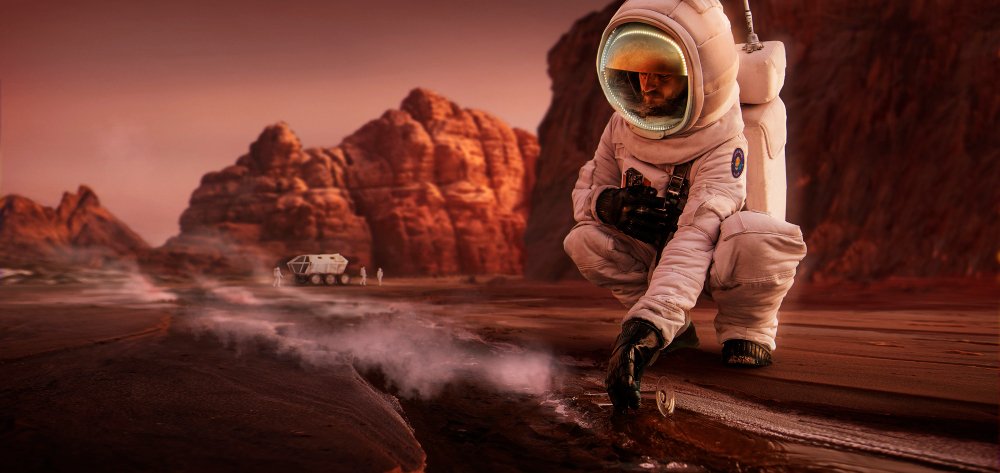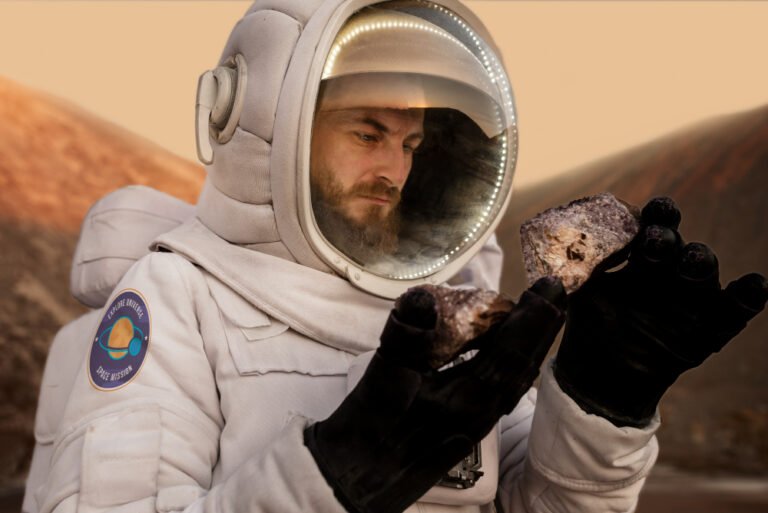The Real Timeline: When Will Humans Actually Live on Mars?

Everyone asks the same urgent question: when will humans actually live on Mars? The short answer people want—“next decade”—looks tempting when you read bold tweets and press briefings. The longer, more useful answer is conditional: humans will step foot on Mars when a chain of technical, political, economic and social milestones are met; they will live on Mars when the follow-on infrastructure, logistics and local resource capacity make repeated habitation safe and economically sustainable. This article gives a realistic, evidence-based timeline (with milestones) from the 2020s through the latter half of the 21st century, explains the technical and policy conditions that control each stage, points to concrete enabling demonstrations already underway, and provides practical takeaways for planners, investors and curious citizens trying to separate plausible roadmaps from hype.

Table of Contents
1 — The short headline timeline (quick view)
- 2026–2029: major uncrewed Starship test missions and more robotic precursor landers; ISRU experiments scale. SpaceX
- Late 2020s–2030s: first crewed missions become technically feasible (NASA’s aspirational 2030s window; SpaceX public aims earlier) but will be short stays and heavily dependent on Earth resupply. NASA
- 2030s–2040s: repeated human campaigns, longer surface stays, routine cargo runs, and demonstration of reliable in-situ resource utilization (ISRU). globalspaceexploration.org
- 2040s–2050s: transition from campaign-style missions to sustained bases with local propellant/water production — limited long-term habitation possible.
- 2050s–2070s and beyond: potential for larger settlements and a self-sustaining local economy if transport, ISRU and political will scale.
These windows are plausible not because one company or agency promises them, but because of the combination of demonstrable tech advances (Starship testing, ISRU pilots), international plans, and the cadence of launch-window opportunities to Mars every ~26 months. SpaceX
2 — Why timeline predictions vary so wildly
Timeline estimates differ because people anchor on different assumptions:
- Optimists assume rapid operational success of reusable ultra-heavy launchers (e.g., Starship), fast regulatory clearance, and plentiful private capital. That compresses cost-per-seat and raises flight cadence.
- Conservatives assume technical setbacks, slower regulatory approvals, limited budgets, and supply-chain issues; they expect decades of gradually ramping capability.
- Agencies (NASA, ESA, CNSA) often give conservative public targets—“as early as the 2030s”—because they must account for technology development, budgets, and international coordination. NASA explicitly frames human Mars missions as feasible in the 2030s but contingent on sustained investments and technology maturation. NASA
Key point: the difference between “first humans on Mars” and “humans living on Mars” is logistic scale. A single flag-planting mission is very different, in cost and risk, from a resident population of dozens or thousands.
3 — Phase 0 — Robotic and infrastructure buildup (2020s) — What’s happening now
The 2020s are fundamentally about de-risking.
What’s already in motion
- Large reusable rockets test flights and rapid iteration. SpaceX’s Starship test program has accelerated in 2024–2025 with multiple orbital attempts and continues to iterate; company plans publicly target early uncrewed Mars payload flights in 2026 or within that ballpark, contingent on successful orbital refueling and regulatory approvals. These tests are essential to demonstrate heavy-lift, payload integration and high flight cadence. SpaceX
- Robotic precursors and technology demonstrations. NASA, ESA and private actors are ramping landers, rovers, and orbital assets that scout landing sites, test entry/landing systems, measure local resources and demonstrate ISRU concepts (e.g., MOXIE on Mars produced oxygen from CO₂). Broader ISRU demonstration programs and roadmaps are part of coordinated global exploration plans. NASA
- Policy and international roadmaps. Documents like the Global Exploration Roadmap and agency plans align investments in navigation, communications, surface power, and ISRU so future human operations have the necessary infrastructure. globalspaceexploration.org
Why this matters: By the end of the 2020s we will know whether key enabling pieces—heavy lift at volume, entry/landing at scale, and initial ISRU feasibility—are workable in practice. That knowledge governs when crewed missions can safely follow.
4 — Phase 1 — First human missions and short stays (late 2020s–2030s)
What “first human missions” mean
A credible first human mission is not a celebrity flag-plant; it’s an integrated crewed campaign with safe transport, surface habitat plans (even if rudimentary), contingency return capabilities, and at least partial mission resilience through redundant systems or forward-deployed caches.
Earliest plausible window (conditional)
- Optimistic path: If large reusable launchers (Starship or equivalents) clear regulatory hurdles, pass aggressive flight-test series and demonstrate orbital refueling, then uncrewed cargo flights in 2026–2028 could seed the surface, and a crewed fly/land mission in the late 2020s to early 2030s becomes technically imaginable. SpaceX has publicly discussed uncrewed missions planned as early as the 2026 launch window; NASA’s public position still conservatively points to the 2030s as its target. SpaceX
Characteristics of these early human missions
- Duration: a few weeks to a few months on-surface, heavily resupplied by Earth, and focused on technology validation (habitat ops, ISRU demonstration, science).
- Risk posture: high; crews will accept elevated operational risk compared with ISS missions.
- Logistics: heavy reliance on pre-deployed cargo (power systems, spare parts), and in some plans, on orbital refueling infrastructure and orbital fuel depots.
Key unknowns that determine timing
- Successful demonstration of orbital refueling and high flight cadence for heavy-lift vehicles.
- Reliable entry, descent and landing (EDL) at human scale: landing 50+ t of payload safely is an enormous technical challenge.
- Robust life-support designs for months-long exposure to deep-space radiation and microgravity transit.
5 — Phase 2 — Repeated missions, extended surface campaigns (2030s–2040s)
If the first crewed missions are successful, the next stage is to make trips routine enough to learn in aggregate.
What changes in this phase
- Increased flight cadence: dozens of cargo and crew missions across several launch windows. SpaceX’s public slide decks envision scaling to dozens or hundreds of Starship flights in a decade if hardware and operations prove economical—but that scale is aspirational and contingency-laden. Wikipedia
- Longer stays: crews living on Mars for months to a year, optimizing surface operations around science, infrastructure assembly, and ISRU scale-up.
- ISRU matures from demo to production: pilot plants produce useful amounts of propellant, oxygen, and water to reduce resupply mass from Earth. ISRU success dramatically lowers the cost and increases resilience of follow-on missions. NASA
Markers of success to watch
- Sustained production runs of propellant or oxygen on Mars demonstrably reducing cargo launch requirements from Earth.
- Routine EDL operations for heavy cargo — scheduled landings with low marginal failure rates.
- A near-term commercial ecosystem for Mars logistics (orbital tugs, in-orbit depots, surface logistics contractors).
Why this phase is the hardest political hurdle
Repeated missions require sustained capital flows and predictable political backing. A single successful mission may win headlines, but habitability and presence require long-term fiscal commitments or profitable commercial pathways (tourism, research services, mining, manufacturing) that remain speculative.
6 — Phase 3 — Sustained bases (2040s–2050s)
Assuming Phase 2 succeeds, we enter a period where “living” starts to mean sustained habitation:
What “sustained base” looks like
- Modular surface bases with reliable power (nuclear microreactors and/or large solar arrays), in-situ water/oxygen/propellant production, and greenhouses supplying a significant fraction of food for resident crews.
- Local manufacturing (3D printing with regolith feedstock) for spare parts and structural elements.
- A logistics rhythm: scheduled cargo resupply that keeps stockpiles for contingencies and growth.
Earliest plausible timing
- With steady investment, notable technology demonstration success, and political/commercial will, sustained bases might be plausible in the 2040s–2050s. This is the timeframe when ISRU and manufacturing scale could convert expensive expeditionary outposts into nominally persistent habitats.
What makes or breaks this phase
- Economics: even with ISRU, the per-person support cost must drop to make long-term basing affordable for governments or profitable for private stakeholders.
- Health science: long-term radiation shielding techniques and biomedical countermeasures must be proven for multi-year stays and potential multi-generational populations.
- Governance & law: legal frameworks around resource use and liability must stabilize enough to allow investment.
7 — Phase 4 — Large semi-permanent settlements and an economy (2050s–2070s+)
Once transport costs fall further, ISRU and manufacturing mature, and initial bases have shown multi-year survival, a new economic logic can appear:
Possible economic drivers
- In-space manufacturing: materials processed in orbit or on Mars (e.g., high-value materials or components benefiting from low gravity manufacturing).
- Propellant production and orbital services (depot fueling for deep-space missions).
- Science and tourism markets: premium visits and research services.
- Data and remote-sensing industries selling unique long-term datasets.
Settlement scale
- The transition to hundreds or thousands of residents depends on transport cost per person, the availability of stable jobs or revenue sources on Mars, and the societal willingness to support off-world migration. This level of settlement is most plausible several decades after sustained bases—so commonly pointed to in the 2060s–2080s window for meaningful population growth, though highly contingent.
Why timing stretches
- Achieving an economy that pays for itself is the most uncertain part. Without exportable goods or valuable services, sustained growth depends on political subsidies (i.e., Earth governments choosing to underwrite colonies).
8 — Key technical and policy milestones that determine the pace
The timetable above is controlled by a handful of gating milestones. Watch these closely:
- Heavy-lift operational reusability at scale — reliable, frequent launches of multi-ton payloads at low marginal cost (e.g., Starship becoming operational and affordable). Failure or delay here is the biggest single schedule risk. SpaceX
- Large-payload entry, descent & landing (EDL) validation — landing tens of tonnes safely on Mars is nontrivial; measurable reductions in EDL risk are needed.
- Orbital refueling & in-space logistics — practical orbital tankers and refueling protocols reduce dependence on single-launch mass budgets.
- ISRU demonstration to production — moving from lab/pilot (MOXIE) demonstrations to continuous production of oxygen/propellant/water on the surface. NASA Technical Reports Server
- Radiation mitigation & long-term health data — solutions beyond temporary shielding or limited-duration missions (better shielding, biological countermeasures).
- Legal & procurement frameworks for sustained investment — long-term international agreements or reliable commercial markets. globalspaceexploration.org
Each of these is a potential choke point. Progress on them is neither guaranteed nor linear.
9 — Risk factors that could delay or accelerate the timeline
Delaying risks
- Technical setbacks (rocket failures, EDL catastrophes, ISRU failures).
- Regulatory restrictions (environmental reviews, licensing delays on novel vehicles).
- Funding shocks — political changes that cut budgets or private investors withdrawing.
- Health surprises — new findings showing long-term human harm from radiation or microgravity that require new mitigation tech. NASA
Accelerating factors
- Breakthroughs in reuse and flight cadence—if a heavy-lift vehicle proves cheap and safe quickly.
- Commercial markets emerging (space tourism, manufacturing, data services) that create self-sustaining revenue streams.
- International cooperation pooling funds and expertise to share costs and political risk. globalspaceexploration.org
10 — Related-items / timeline table (milestones, indicators, earliest plausible windows)
| Milestone / Indicator | Why it matters | Earliest plausible window (if successful) |
|---|---|---|
| Starship heavy-lift operational at cadence | Lowers transport cost per kg/person | 2026–2030 (test → early ops) — conditional. SpaceX |
| First uncrewed large-cargo missions to Mars | Allows surface pre-deployment | 2026–2029 (optimistic company plans) Wikipedia |
| First crewed mission (short stay) | Marks first humans on Mars | Late 2020s–2030s (very contingent) NASA |
| ISRU pilot → production scale (propellant/water) | Reduces Earth-supply dependence | 2030s–2040s (depends on demonstrations). NASA Technical Reports Server |
| Repeated missions & routine EDL | Operational cadence & reliability | 2030s–2040s |
| Sustained bases with local manufacturing | Supports long-term residence | 2040s–2050s |
| Self-sustaining economic activities | Pays for logistics & growth | 2050s–2070s+ |
11 — FAQs (7)
Q1 — Will Elon Musk’s timeline (humans in a few years) happen?
Elon Musk and SpaceX have repeatedly given aggressive timelines (e.g., aiming for initial uncrewed missions around 2026), and private plans can sometimes move faster than government programs. However, such timelines are conditional—they depend on a string of technical successes (orbital refueling, EDL scale, regulatory approval) that are still in testing. If every test goes well and financing holds, accelerated crewed missions could happen earlier than conservative agency estimates. If not, schedules will slip. SpaceX
Q2 — What’s the difference between “visit” and “live” on Mars?
A visit: short stay (days–months), crews largely supported by Earth resupply. Live: sustained habitation with local resource production, regular rotation of personnel, and a permanent logistics chain. The latter requires ISRU, manufacturing and a cadence of flights that reduces Earth dependency.
Q3 — How important is ISRU really?
Crucial. ISRU is the single largest lever for reducing long-term costs and making living on Mars sustainable (water, oxygen, propellant, construction feedstock). Demonstrations like MOXIE (oxygen from CO₂) are early but more production-scale ISRU is needed for cost-effective habitation. NASA
Q4 — Do politics and budgets matter more than technology?
Both matter. Technology can reach readiness, but without political will and funding (or viable commercial economics), programs stall. Long-term presence requires multi-year commitments that outlast political cycles or credible commercial markets.
Q5 — What are the biggest unknowns about human health on Mars?
Radiation exposure and the physiological effects of long-duration deep-space transit (bone loss, muscle atrophy, neuro-ocular effects) remain key concerns. Mitigation strategies (shielding, pharmaceuticals, artificial gravity concepts) are being studied but not yet fully proven for multi-year population health. NASA
Q6 — Could other countries get people to Mars faster than the US/SpaceX?
Possibly. National programs (China’s CNSA, Russia’s Roscosmos, the ESA in partnership models) could prioritize human Mars missions if they marshal sufficient resources. International partnerships or competition can both accelerate or complicate timelines. globalspaceexploration.org
Q7 — How should investors or startups think about this timeline?
Invest where milestones are near-term and de-riskable: ISRU hardware, landing/EDL tech, in-space logistics, life-support systems, radiation protection, and orbital/refueling infrastructure. These are the building blocks that will be needed whether governments or private companies lead.
12 — Conclusion: What to watch — realistic signals that “we’ve arrived”
Predicting a date for humans living on Mars is tempting but dangerous—time estimates hinge on multiple dependent breakthroughs. Instead of chasing a calendar date, watch concrete signals:
- Heavy-lift reusability proven at scale: repeated, low-cost flights with fast turnaround. SpaceX
- Large-payload EDL success: safely delivering tens of tonnes on Mars’ surface reliably.
- ISRU moving from demo to regular production: measurable propellant/oxygen output lowering Earth-supplied mass. NASA Technical Reports Server
- Sustained political/commercial funding and international frameworks supporting multi-year programs. globalspaceexploration.org
- Medical and long-duration human health solutions (radiation reduction, effective countermeasures to microgravity effects).
When those elements align, the phrase “people live on Mars” moves from aspirational rhetoric to a plausible, sustained reality. Practically speaking, the first humans may step onto Mars within the 2030s under optimistic paths; humans living there regularly and sustainably is a multi-decade process likely to stretch into the 2040s–2060s or beyond, depending on success across the milestones above.






